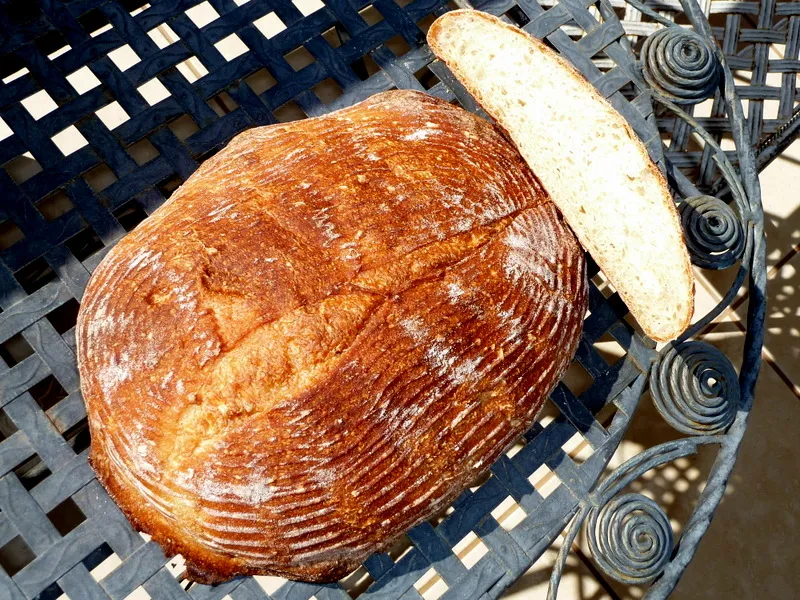
These embarrassing loaves are Hamelman's Country Bread recipe. 68% hydration and 50% pre-fermented dough. I measured carefully by weight, but even at the mixing stage the dough was very sticky. I added a quarter cup of flour, which helped the dough pull away from the bowl a bit. It still seemed incredibly sticky to me, but I forged on.
I've baked with some moderate success before, but even lifting carefully with the scraper and flouring the board a bit, the dough stuck like an octopus. The bulk fermentation seemed OK. I used Bertinet's slap and fold to try and get some gluten strength, but even with three folding sessions I wasn't able to get the dough to completely let go of the board (or my hands).
When I dumped the dough out to shape it, it flattened out right away. I unstuck it from the board, scraped it together, tried to tighten the skin (hah!) and plopped it into bannetons. It rose moderately in the banneton, but when I emptied the banneton on a peel, the loaf took the shape seen in the photo. No oven spring that I could detect.
So, help please, fellow bakers. What might have contributed to this fiasco? I'd like to manage high hydration breads as my skills increase, but if they work out like this I'm already discouraged.
Thank you very much.
GregS
Well GregS, the crust looks beautiful. I have never really seen a tall loaf of holey (high hydration) bread. They are usually flatter like Ciabatta and focaccia. And when you say 50% preferment, thats not sourdough, right? There is nothing under the sun that is going to stick like sourdough. NASA should use that stuff to secure heat tiles. Pre-ferment is sticky, but not so much as sourdough. I would say just a tad more flour next time. Your flour, the season, the humidity, all might have contributed to the differences compared to what the original recipe resulted in. Did it taste great? When it comes down to it, thats what you want. More flour, up to 1/4 cup more might have made all the difference. But then I have not seen the recipe. Also, perhaps let it raise in something that does not need as much handling. Like putting the dough in a parchment sling,letting it raise in a large bowl. I hope this helped.
The preferment was not sourdough. I wondered if the 50% preferment, which rose for 12 hours before incorporation, might have lost some of its gluten structure. I live in Hawaii, so this time of year the temperature ranges between 80 and 70 (sorry heat sufferers). I'll keep trying to figure this out, because the bread was very tasty.
and the preferment is usually between 8 and 16 hrs depending on the environment etc.
I would say that your pre-ferment went too long at 12 hrs. Try a shorter time, say 10 or 8 hrs and see what happens.
Mini
If memory serves me well, the preferment for this recipe is pâte fermentée and a very stiff one.
If the problem is a stiff pate fermente going liquid, creating it from a runny to a thick starter, then thiol compounds could be involved. Slowly building to a firm starter, adding more % flour with each feed over a few days, letting the starter mature on its own between feeds, might be one way to handle the conversion to a firm starter.
Mini, it's yeasted. Greg's problem, we must understand, is with the final build.
Man! My grey matter needs coffee fast! ...or maybe some cinnamon rolls... :)
I will stay out of this, my brain is enjoying BC too much and is still on holiday. Please forgive me!
(one more try): How about a smaller basket for proofing? One that is taller/deeper? More folds? Roll that loaf in plenty of flour too!
I like the looks of the loaf despite any problems. If the loaf is cut more //// diagonally, the slices get bigger. (Is my coffee beginning to work yet?) (It's Hills Bros. one would think it would raise something...)
In my case, a high amount of sourdough starter incorporated into the dough made it impossible to work with. And I do mean impossible. I was not following a recipe, just playing around. I ended up adding more flour and water, to make the ratio of starter lower overall, about 25%. I know you said you're not using sourdough, and you're following a recipe, so I don't know if your problem could be related or not. I've also read that using water that is too soft will make your dough very sticky and hard to work with. I've been using distilled water for a long time, and my dough, sure enough, is always very sticky. Perhaps I'm a masochist baker. But, if you wish to relieve yourself of this problem, I would suggest looking at those two possibilities.
Another thing, since you brought up the possibility of the flour in the preferment losing some of its gluten structure. How much gluten is in your flour? You should be using a strong bread flour for that recipe, if you want to see a significant rise. Also, if you're using 50% preferment, you should check your rising times. You may be overproofing the loaf a bit, which might explain your lack of oven spring. One thing to remember is to watch the dough, not the clock so much. Your environment is going to be a little (maybe a lot) different from the environment the recipe was developed in.
Greg, if you could completely eliminate a probability of deviating from the original formula, this would be a rare occasion when I suggest using stronger flour.